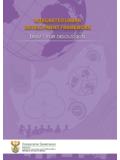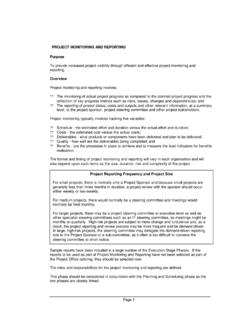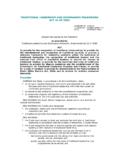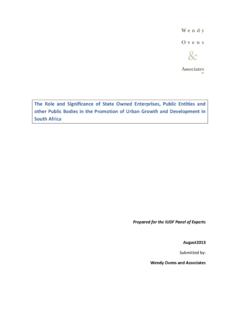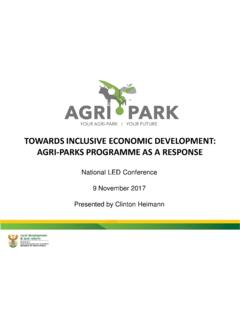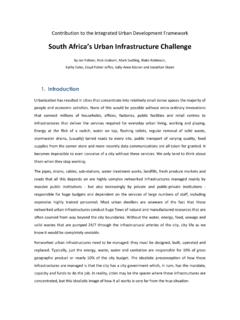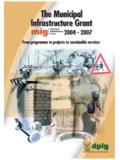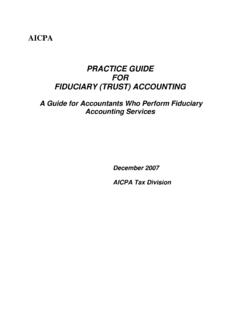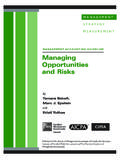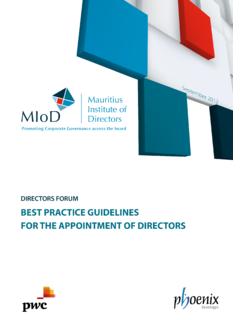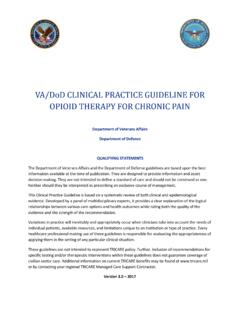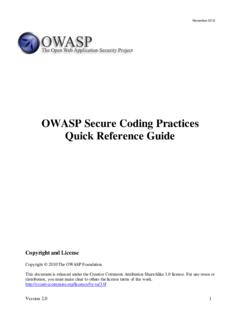Transcription of GUIDELINES FOR INFRASTRUCTURE ASSET …
1 GOVERNMENT2006 - 2009" GUIDELINES FORINFRASTRUCTURE ASSETMANAGEMENT INLOCAL GOVERNMENT2006 2009 ACKNOWLEDGEMENTS Project Sponsor Molatelo Montwedi Executive Manager Municipal INFRASTRUCTURE , dplg Authors Louis Boshoff Assignment Leader (i @ Consulting) Rob Childs (i @ Consulting) Lisa Roberts (Maunsell) Stakeholder inputs The participation of a number of stakeholder groups is gratefully acknowledged. The inputs of the following parties in particular deserve notice: * Cities Network Focus Group on INFRASTRUCTURE (Buffalo City local Municipality, City of Cape Town Metropolitan Municipality,City of Johannesburg Metropolitan Municipality, Ekurhuleni Metropolitan Municipality, Ethekwini Metropolitan Municipality, Msunduzi local Municipality, Nelson Mandela Metropolitan Municipality, Tshwane Metropolitan Municipality) * Members of the Municipal INFRASTRUCTURE Technical Task Team (MIT3) * Office of the Accountant General (Hester Hermus) * Department of Water Affairs and Forestry (Fred van Zyl) Illustrations, lay-out and design Chantel Colyn (i @ Consulting) Case study material Capricorn District Municipality Lephalale Municipality SPECIAL ACKNOWLEDGEMENTS The authors wish to thank the Association of local Government Engineering NZ Inc (INGENIUM) and the National ASSET management Steering (NAMS)
2 Group, whose work as contained in the International INFRASTRUCTURE management Manual (International Edition 2006) and other products provided the concepts that underpin this Guideline. The NAMS Group (NZ) has given written permission for the use of specific extracts from their publications in this guideline. This concession enables this Guideline to be modeled upon best international ASSET practices. Copyright subsists in this work. No part of this work may be reproduced in any form or by any means without the publisher s written permission. Any unauthorised reproduction of this work will constitute a copyright infringement and render the doer liable under civil and criminal law. Whilst every effort has been made to ensure that the information in this work is accurate, no responsibility for any loss or damage suffered by any person as a result of the reliance upon the information contained therein.
3 Any inquiries regarding the publication should be directed to: Chief Directorate: Municipal INFRASTRUCTURE Department of Provincial and local Government Private Bag X804 Pretoria 0001 Tel: (012) 334 4995 Fax: (012) 334 0540 " GUIDELINES FOR INFRASTRUCTURE ASSET management IN local GOVERNMENT 2006 - 2009" FOREWORD Municipalities are custodians of community INFRASTRUCTURE such as roads, waste disposal sites, water and sanitation systems, and public facilities. As Government, we are committed to extend INFRASTRUCTURE service delivery to all South Africans. To this end we have created the Municipal INFRASTRUCTURE Grant in 2004 to assist municipalities to complement the capital budgets of municipalities for the provision of INFRASTRUCTURE to the poor communities. In March 2006, Cabinet approved the National INFRASTRUCTURE Maintenance Strategy and so reinforced Government s support for the protection of community assets through well considered maintenance and renewal strategies aimed at furthering the objective of sustainable INFRASTRUCTURE services delivery.
4 INFRASTRUCTURE is the cornerstone of social upliftment, public health and safety. INFRASTRUCTURE is essential to achieve the increased levels of economic growth through job creation and the establishment of well serviced areas conducive for economic investment. INFRASTRUCTURE assets and community facilities are complex by nature and require robust management practices. Sound knowledge of the location, characteristics, estimated lives, capacity and utilisation, cost characteristics, risk exposure and safety requirements of assets is required to best manage them and make sustainable improvements in service delivery. We support local government in achieving programmes that promote sustainable quality of life to all citizens. As part of a broader and ongoing support framework, we have developed this guide with inputs from local government practitioners.
5 This guide has been compiled to assist municipal immovable ASSET managers. In particular, its application will assist in strengthening IDP processes and outcomes, the implementation of generally accepted municipal accounting practices related to immovable assets, improve INFRASTRUCTURE investment planning efforts and other municipal systems related to municipal INFRASTRUCTURE . The guide draws on internationally accepted best practice, but has a strong South African flavor, given our unique context. The Office of the Accountant General has also been involved in ensuring compliance with local government specific accounting standards, and that sound financial ASSET management practices are embodied in this Guideline. Thus international best practice is presented in a manner that meets local legislative requirements and addresses local challenges.
6 Case studies of how South African municipalities have successfully implemented ASSET management practices are provided. This guide has been prepared specifically to assist small to medium size local municipalities in addressing the INFRASTRUCTURE management challenges that they face. The techniques are as far as possible presented in a format that is easy to understand and apply, supplemented by practical examples. Whilst larger, more capacitated municipalities may wish to apply more advanced techniques and systems, we believe that they will also benefit from the principles, frameworks, processes and techniques described in this guide. GUIDELINES FOR INFRASTRUCTURE ASSET management IN local GOVERNMENT i dplg TABLE OF CONTENTS DEFINITIONS .. v ACRONYMS .. x LIST OF xii xiii 1. INTRODUCTION TO INFRASTRUCTURE ASSET 1-1 1-1 National 1-2 Key ASSET management Concepts.
7 1-3 International INFRASTRUCTURE management Manual .. 1-5 Legislative Framework .. 1-5 Technical Norms and Standards .. 1-7 Accounting Standards .. 1-8 Terminology .. 1-9 2. STRATEGIC FRAMEWORK FOR INFRASTRUCTURE ASSET 2-1 Introduction .. 2-1 Legislative Drivers for the ASSET management Framework .. 2-1 INFRASTRUCTURE ASSET management Framework .. 2-2 INFRASTRUCTURE ASSET management Policy .. 2-3 ASSET management 2-6 INFRASTRUCTURE ASSET management Plans .. 2-7 Comprehensive Municipal INFRASTRUCTURE 2-7 Minimum Requirements .. 2-8 Summary .. 2-8 3. GETTING STARTED .. 3-1 Approaches to Starting Out .. 3-1 Setting up the Enablers .. 3-2 Critical Success Factors .. 3-5 3-5 4. INFRASTRUCTURE ASSET management PLAN .. 4-1 Approach .. 4-1 Minimum Requirements .. 4-2 Document Format.
8 4-3 Methodology .. 4-6 Selecting the Appropriate Level of 4-7 4-7 GUIDELINES FOR INFRASTRUCTURE ASSET management IN local GOVERNMENT ii dplg 5. COMPREHENSIVE MUNICIPAL INFRASTRUCTURE PLAN (CMIP) .. 5-1 The purpose of CMIP .. 5-1 Process for Developing the CMIP .. 5-3 CMIP Format .. 5-5 Minimum Requirements for a 5-6 Summary .. 5-6 6. BASIC ASSET management 6-1 Information and Data 6-1 ASSET Establishing Levels of Service ..6-18 Risk management ..6-31 Life-cycle Plan ..6-36 Financial Planning ..6-40 ASSET management Practice Improvement Plan ..6-55 IAM Plan Adoption ..6-60 Consolidating ASSET information and strategies for the CMIP ..6-60 7. REFERENCES .. 7-1 LIST OF FIGURES AND TABLES: Figure 1-1: Comprehensive Municipal INFRASTRUCTURE Plans Figure 1-2: Lifecycle of an ASSET Figure 1-3: Lifecycle ASSET management Figure 1-4: local Government Specific Legislation Figure 1-5: Overview of Definitions of IAM Expenditure Categories Figure 2-1: Strategic INFRASTRUCTURE ASSET management Framework Figure 2-2: Policy and Strategic Framework Figure 3-1: Getting started with an ASSET management programme Figure 3-2: Typical ASSET management Team Structure Figure 3-3: Example Roadmap for Establishing a Comprehensive IAM System for a Large Municipality Figure 3-4: Case study: How the Lephalale Municipality approached ASSET management Figure 4-1: Process for Preparing an ASSET management Plan Figure 4-2: Example Methodology for Preparation of an IAMP Figure 4-3: Format of an IAM Plan Figure 5-1.
9 Integration of INFRASTRUCTURE ASSET management Plans Figure 5-2: INFRASTRUCTURE inputs to the IDP Figure 5-3: CMIP feeding into draft IDP Figure 5-4: Typical Format of CMIP Figure 6-1: Process for Establishing an INFRASTRUCTURE ASSET Register Figure 6-2: INFRASTRUCTURE ASSET Lifecycle Cost Models Figure 6-3: Possible systems linkages to the ASSET Register Figure 6-4: Typical deterioration curve GUIDELINES FOR INFRASTRUCTURE ASSET management IN local GOVERNMENT iii dplg Figure 6-5: Nature and Extent of Assets Figure 6-6: Length, Age and Material Water Reticulation Figure 6-7: Example ASSET Age Summary Figure 6-8: Example ASSET Condition Summary Figure 6-9: Example Remaining Useful Life Summary Figure 6-10: Example Data Accuracy Summary Figure 6-11: Levels of service Figure 6-12: IDP Consultation Process Figure 6-13: Demand management options Figure 6-14: INFRASTRUCTURE Enhancement Needs Driven by Future Demand Profile Figure 6-15: ASSET Criticality Distribution Figure 6-16: Example of Life-cycle Budget Needs Figure 6-17: Investment decision process Figure 6-18: Levels of ODM Figure 6-19: DCF formula Figure 6-20: Financial decision indicators Figure 6-21: BCR in action Figure 6-22: Option A: Multi-criteria Analysis Figure 6-23: Option B: Multi-criteria Analysis Figure 6-24: Examples of sector level prioritization Figure 6-25: Scenario A: Base case to maintain existing service levels Figure 6-26: Scenario B: Moderate level of service improvements Figure 6-27: Determining unit cost for tariff setting purposes Figure 6-28: Total ASSET management Process (Source: IIMM) Figure 6-29: Scope of INFRASTRUCTURE management practices Figure 6-30.
10 Improvement Process Table 1-1: Sector Specific Legislation Table 5-1: A 3-year process for developing a CMIP Table 5-2: Criteria for minimum requirements for a CMIP Table 6-1: Potential service document used in for preparing an IAM plan Table 6-2: Example of PPE sub-categories Table 6-3: Example ASSET Hierarchy Table 6-4: Example Expected Useful Life of Assets Table 6-5: Generic Condition Grading Table 6-6: Condition Grading Lined Channels Table 6-7: Data Accuracy Table 6-8: Consequence of Failure generic Table 6-9: Criticality Grading Table 6-10: Example Water Service Standards Table 6-11: Example Road Transport Service Standards Table 6-12: Sanitation Service Standards Table 6-13: Example Stormwater Drainage Service Standards GUIDELINES FOR INFRASTRUCTURE ASSET management IN local GOVERNMENT iv dplg Table 6-14: Example Solid Waste Service Standards Table 6-15: Example Electricity Service Standards Table 6-16: Example Parks Service Standards Table 6-17: Example Building Service Standards Table 6-18: Factors influencing Demand Table 6-19: Commonly Encountered Risks Table 6-20: Example Risk Consequence Rating Network Level Table 6-21: Probability Rating- Network Level Table 6-22: Probability Rating- ASSET Level (condition-based failure) Table 6-23: Risk Exposure Matrix Table 6-24: Life Cycle Cost Example Table 6-25: Practices scoring approach Table 6-26: Typical Milestones in Improvement of ASSET management World Bank Advisory Note Table 6-27: Sample practices improvement project plan Table 6-28: Ranking of Improvement Needs ANNEXURES A.
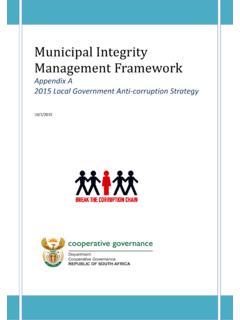
![Disaster Management Act [No. 57 of 2002]](/cache/preview/e/5/d/2/b/3/6/7/thumb-e5d2b36743b64ebe9204d7e874f734ad.jpg)
